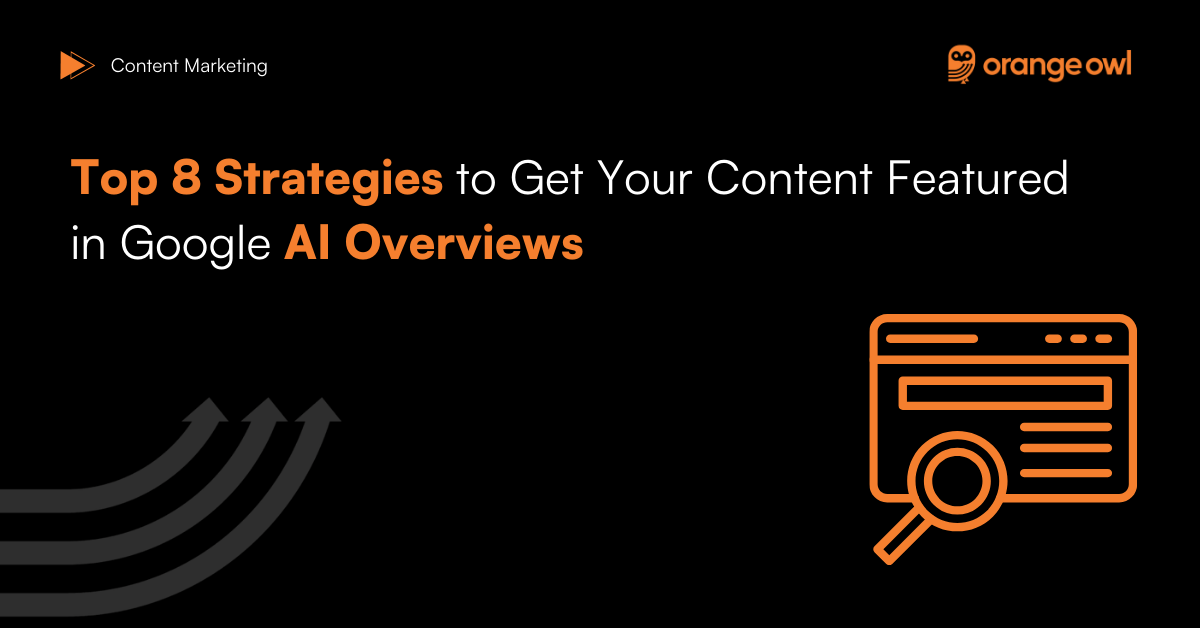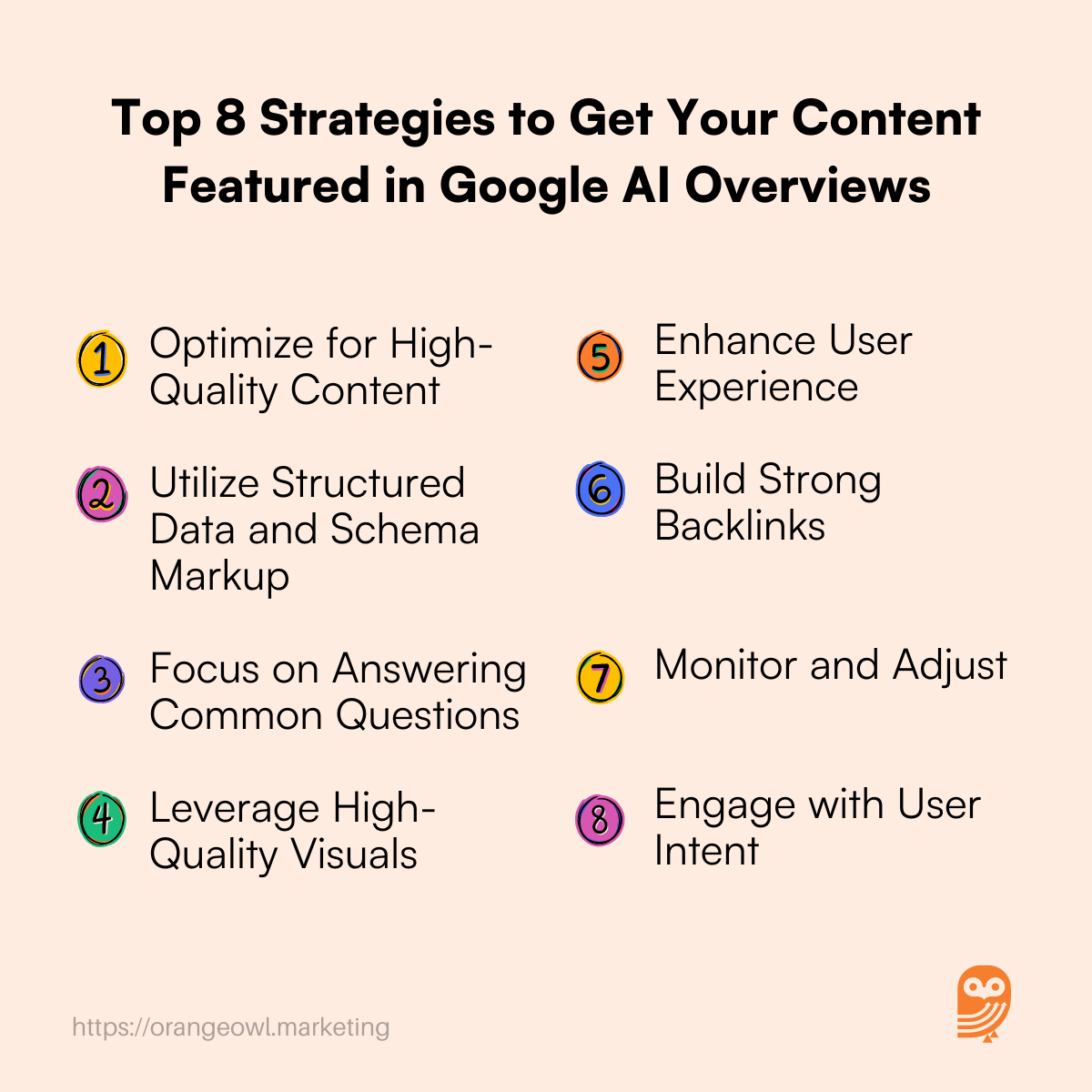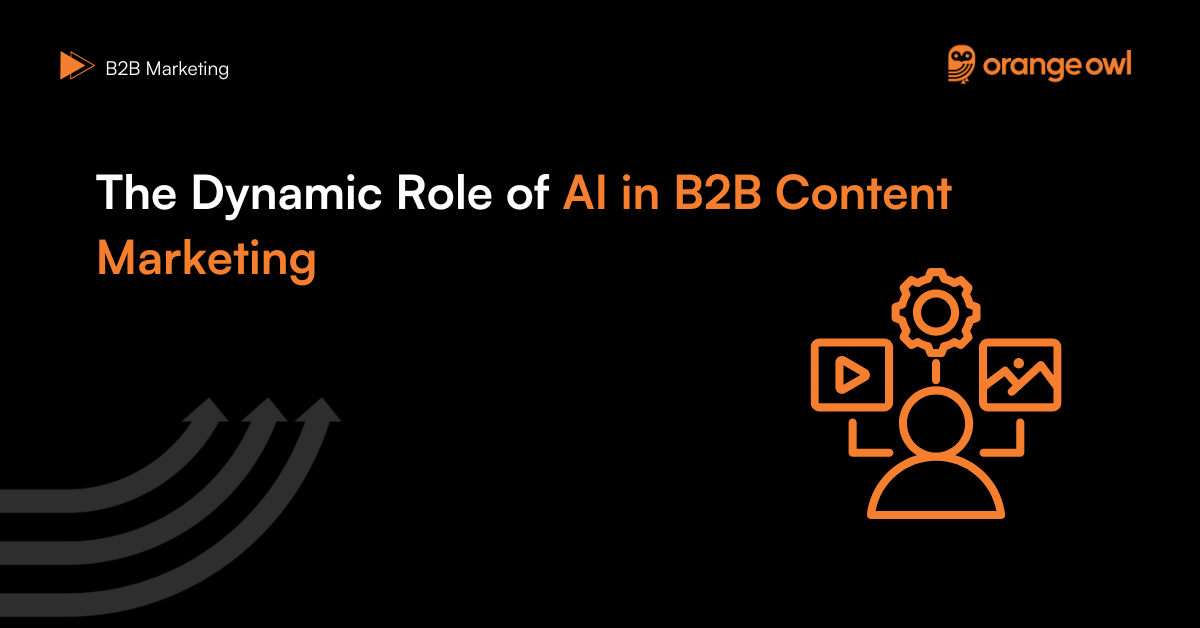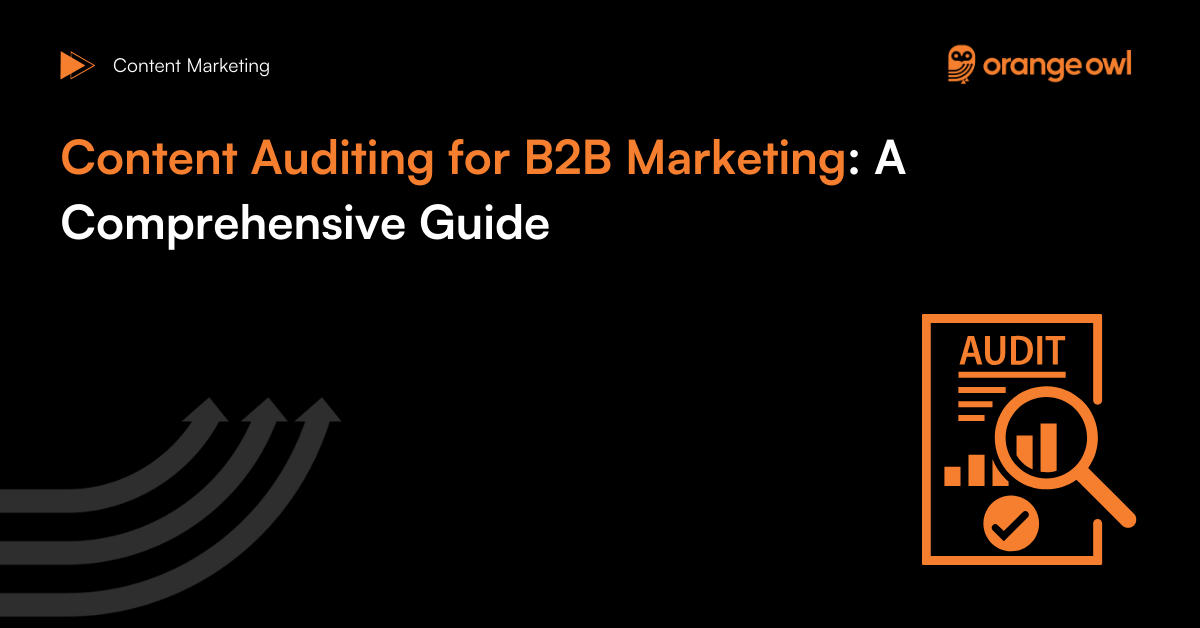Top 8 Strategies to Get Your Content Featured in Google AI Overviews
Vivek Goel
February 4, 2025

Table of Contents
Google AI Overviews are a powerful feature that can significantly boost your visibility in search engine results. These overviews provide users with quick, relevant information directly in search results, which can drive more traffic to your website. To get your content featured in google ai overviews, it’s crucial to optimize it effectively. Here’s a comprehensive guide on how to achieve this:
Introduction
In the rapidly evolving digital landscape, securing a spot in Google’s AI Overviews can offer a competitive edge. According to the AI Overview Study by Advanced Web Ranking, AI-generated summaries provide quick, relevant information directly in search results, changing how users interact with search engines and affecting organic traffic to websites.
As per the study, only 33.4% of AI Overview links rank in the query’s top 10 organic results, while 46.5% of URLs included in AI Overviews rank outside the top 50 organic results. This indicates that even if your website ranks well organically, it doesn’t guarantee inclusion in AI Overviews. Optimizing your content specifically for AI Overviews is essential to stay ahead in search game.
Key Strategies to Feature Your Content in Google AI Overviews
Strategy 1: Optimize for High-Quality Content
Creating high-quality content is the foundation of any successful SEO strategy. For AI Overviews, this means focusing on Expertise, Authoritativeness, and Trustworthiness (E-A-T).
1.1 Focus on E-A-T (Expertise, Authoritativeness, Trustworthiness)
Google prioritizes content from credible sources. Ensure your content is well-researched and authored by experts in the field.
Example: A B2B technology blog that includes insights from industry experts will likely rank higher.
Actionable Steps:
- Conduct thorough research and cite reputable sources.
- Collaborate with industry experts for guest posts or interviews.
- Regularly update content to maintain accuracy and relevance.
1.2 Create Comprehensive and Detailed Content
AI Overviews prefer content that provides thorough and in-depth information. Aim to cover topics comprehensively and answer all potential user queries.
Example: A B2B marketing agency writing about “Account-Based Marketing” should cover definitions, strategies, examples, and benefits in detail.
Actionable Steps:
- Use content outlines to ensure all aspects of a topic are covered.
- Include case studies, examples, and actionable tips.
- Break down complex topics into easy-to-understand sections.
Strategy 2: Utilize Structured Data and Schema Markup
Using structured data helps search engines understand the context and structure of your content. Implement schema markup relevant to your content type.
2.1 Implement Schema Markup
Structured data can help search engines understand your content better, increasing the likelihood of being featured in AI Overviews.
Example: A B2B software company using FAQ schema for their support pages to help Google identify and display relevant answers.
Actionable Steps:
- Use Google’s Structured Data Markup Helper to add schema markup.
- Validate your structured data using the Rich Results Test tool.
- Regularly update and audit your schema markup for accuracy.
2.2 Use Lists and Tables
Organize information into lists and tables where appropriate. AI Overviews often feature content that is easy to parse and present in a structured format.
Example: A B2B financial services firm listing “Top 10 Financial Planning Tips” in a numbered list.
Actionable Steps:
- Format content using bullet points, numbered lists, and tables.
- Ensure that lists and tables are clear and concise.
- Use HTML tags to create lists and tables in your content.

Strategy 3: Focus on Answering Common Questions
AI Overviews often feature content that directly answers common user queries. Target long-tail keywords and create FAQ sections to address these questions.
3.1 Target Long-Tail Keywords
Long-tail keywords often trigger AI Overviews because they reflect specific user queries. Use tools like Google’s Keyword Planner and AnswerThePublic to identify these keywords.
Example: A B2B cybersecurity company targeting the keyword “How to secure a small business network.”
Actionable Steps:
- Conduct keyword research to find long-tail keywords relevant to your industry.
- Integrate these keywords naturally into your content.
- Monitor keyword performance and adjust your strategy as needed.
3.2 Create FAQ Sections
Incorporate FAQ sections in your content to address common questions directly. These sections are likely to be picked up by AI Overviews.
Example: A B2B HR consulting firm including a FAQ section on “Common HR Challenges for Small Businesses.”
Actionable Steps:
- Identify common questions in your industry using tools like AnswerThePublic.
- Create a dedicated FAQ section on your website or within relevant content.
- Use structured data to mark up FAQ content for better visibility.
Strategy 4: Leverage High-Quality Visuals
Visual content can enhance the user experience and is often included in AI Overviews. Use high-quality images and videos to complement your text.
4.1 Include Relevant Images and Videos
Visual content can enhance the user experience and is often included in AI Overviews. Use high-quality images and videos to complement your text.
Example: A B2B manufacturing company creating explainer videos for complex machinery processes.
Actionable Steps:
- Create or source high-quality images and videos relevant to your content.
- Optimize images by compressing files and using descriptive alt text.
- Embed videos directly in your content and provide transcriptions.
4.2 Optimize Image Alt Text
Ensure all images have descriptive alt text that accurately describes the content. This helps Google understand and potentially feature your visuals.
Example: A B2B e-commerce platform using detailed alt text for product images.
Actionable Steps:
- Write concise, descriptive alt text for every image.
- Include relevant keywords in your alt text where appropriate.
- Regularly review and update alt text for accuracy and relevance.
Strategy 5: Enhance User Experience
Improving user experience on your site is crucial for SEO and for being featured in AI Overviews. Focus on page load speed and mobile-friendliness.
5.1 Improve Page Load Speed
Fast-loading pages provide a better user experience and are favored by Google. Use tools like Google PageSpeed Insights to optimize your page load times.
Example: A B2B SaaS company optimizing their landing pages to load faster, reducing bounce rates.
Actionable Steps:
- Compress images and use lazy loading to improve load times.
- Minimize HTTP requests by combining files.
- Use a content delivery network (CDN) to reduce latency.
5.2 Ensure Mobile-Friendliness
With more users accessing content via mobile devices, it’s crucial that your site is mobile-friendly. Use responsive design to ensure your content displays well on all devices.
Example: A B2B event planning firm ensuring their event registration pages are fully functional on mobile devices.
Actionable Steps:
- Use responsive web design to adapt your site to different screen sizes.
- Test your site’s mobile performance using Google’s Mobile-Friendly Test tool.
- Simplify navigation and reduce clutter for mobile users.
Strategy 6. Build Strong Backlinks
Backlinks from authoritative sites signal to Google that your content is valuable and credible. Focus on building relationships and earning backlinks from reputable sources.
6.1 Acquire High-Quality Backlinks
Backlinks from authoritative sites signal to Google that your content is valuable and credible. Focus on building relationships and earning backlinks from reputable sources.
Example: A B2B consultancy getting featured in industry publications like Forbes or Harvard Business Review.
Actionable Steps:
- Reach out to industry influencers and publications for guest posting opportunities.
- Create high-quality content that others want to link to.
- Use tools like Ahrefs or SEMrush to monitor your backlink profile.
6.2 Guest Blogging
Write guest posts for high-authority blogs in your industry. Include links back to your content to boost its authority.
Example: A B2B marketing expert writing a guest post for a popular marketing blog and linking back to their own detailed guide on digital marketing strategies.
Actionable Steps:
- Identify high-authority blogs in your industry for guest posting opportunities.
- Pitch relevant and valuable content ideas to blog editors.
- Include strategic links back to your content within the guest post.
Strategy 7: Monitor and Adjust
Regular monitoring and adjustment are essential to maintain and improve your rankings. Use SEO tools to track your performance and make necessary changes.
7.1 Use SEO Tools
Utilize SEO tools like SEMrush, Ahrefs, and Moz to monitor your rankings and identify opportunities for improvement. Track which of your pages are being featured in AI Overviews.
Example: A B2B logistics company using SEMrush to track keyword performance and optimize underperforming content.
Actionable Steps:
- Set up regular performance reviews using tools like Google Analytics and SEMrush.
- Identify which pages are featured in AI Overviews and analyze their characteristics.
- Adjust your content strategy based on performance data.
7.2 Update Content Regularly
Keep your content up-to-date with the latest information and trends. Regular updates can help maintain and improve your rankings.
Example: A B2B healthcare provider regularly updating their content on healthcare regulations to reflect the latest changes.
Actionable Steps:
- Schedule regular content audits to identify outdated information.
- Update statistics, links, and information to keep content current.
- Add new insights or sections based on emerging trends and developments.
Strategy 8. Engage with User Intent
Tailoring your content to match user intent is crucial for SEO success. Understand what your audience is searching for and create content that meets those needs.
8.1 Analyze Search Intent
Understand whether users are looking for information, navigation, transaction, or commercial content. Tailor your content to match these intents.
Example: A B2B software company creating detailed guides for informational queries like “how to integrate CRM software.”
Actionable Steps:
- Use tools like Google Analytics and Search Console to analyze user intent.
- Create content that aligns with different stages of the buyer’s journey.
- Regularly review and update your content to match evolving user needs.
8.2 Create Relevant and Engaging Content
Ensure your content is relevant, engaging, and valuable to your target audience. This increases the likelihood of being featured in AI Overviews.
Example: A B2B financial services firm publishing engaging articles on financial planning for small businesses.
Actionable Steps:
- Conduct audience research to understand their needs and preferences.
- Use storytelling and real-world examples to make your content engaging.
- Incorporate interactive elements like quizzes and polls to increase engagement.
Conclusion
Google AI Overviews represent a significant shift in how search engines display information, offering both challenges and opportunities for B2B marketers. By optimizing your content with high-quality information, structured data, and a focus on user experience, you can improve the chances to feature your content in Google AI overviews. Regular monitoring and adjustments, along with a keen understanding of user intent, will help you stay ahead in the competitive landscape of search engine optimization. Embrace these strategies to enhance your visibility, drive more traffic, and achieve better business outcomes in the age of AI-enhanced search results.
Top Frequently Asked Questions (FAQs) on Google AI Overviews
Tracking the performance of your content in Google AI Overviews involves using various analytics tools and monitoring key metrics. Start by setting up Google Analytics to track traffic sources, user engagement, and conversion rates. Utilize tools like SEMrush or Ahrefs to monitor keyword rankings and visibility. Create custom reports to specifically track the appearance of your content in AI Overviews and analyze the impact on organic traffic. Regularly review these metrics to identify trends and optimize your content strategy accordingly.
Google AI Overviews tend to favor content that is informative, authoritative, and directly answers user queries. Types of content that are more likely to be featured include how-to guides, detailed explanations, lists, FAQs, and content from trusted sources within specific niches. Ensuring your content is comprehensive, well-structured, and includes clear, concise answers to potential queries can increase the likelihood of being included in AI Overviews.
AI Overviews can significantly impact CTR and organic traffic. Since AI Overviews provide quick, concise answers directly on the SERP, users may find the information they need without clicking through to the actual website, potentially reducing CTR and organic traffic. However, the inclusion of links within AI Overviews can drive targeted traffic to your site if users seek more detailed information. Optimizing your content to be featured in AI Overviews can enhance visibility and brand authority, even if it affects CTR.
To meet Google’s quality standards for AI Overviews, businesses should focus on creating high-quality, user-centric content. This includes conducting thorough research, using credible sources, and ensuring content is accurate, up-to-date, and relevant. Incorporate structured data and schema markup to help search engines understand and categorize your content better. Additionally, regularly update and audit your content to maintain its relevance and authority.
Yes, optimizing for AI Overviews requires some adjustments to traditional SEO practices. While traditional SEO focuses on keyword optimization and link building, optimizing for AI Overviews involves creating content that directly answers user queries in a concise and structured manner. Use natural language processing (NLP) techniques to match the way users search. Focus on long-tail keywords and question-based queries. Additionally, ensure your content is well-organized with clear headings, lists, and bullet points to enhance readability and relevance for AI Overviews.


